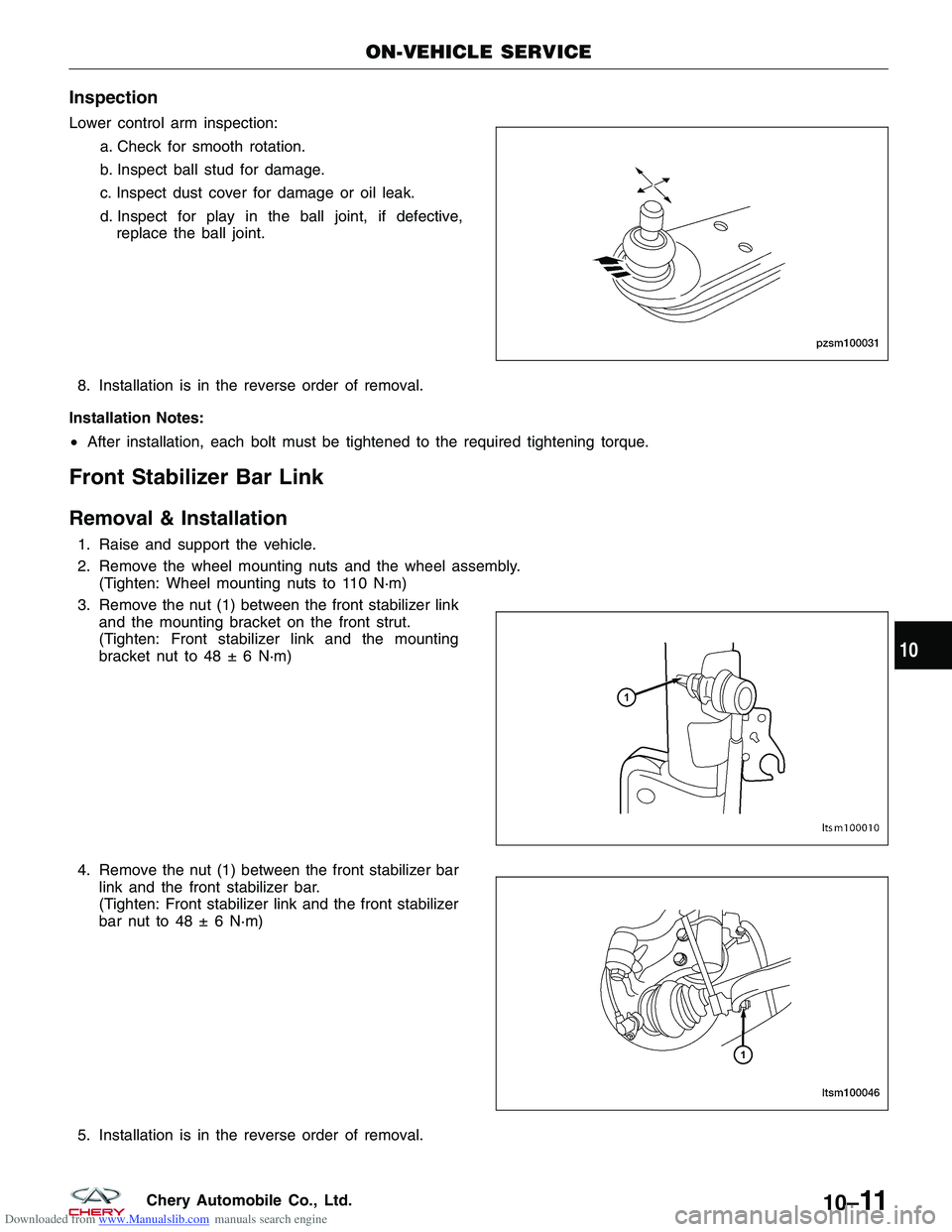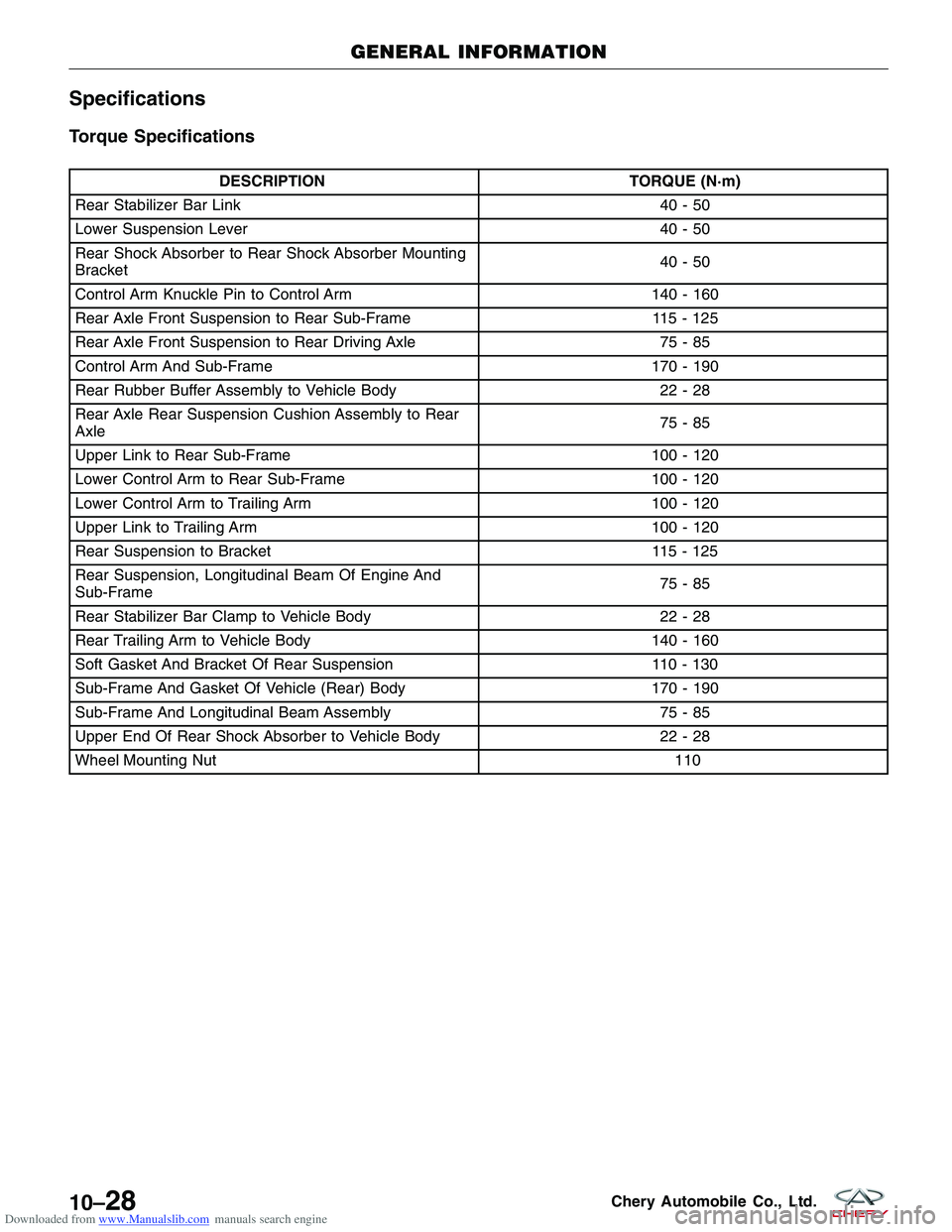Page 1306 of 1903
Downloaded from www.Manualslib.com manuals search engine DESCRIPTIONTORQUE (N·m)
Longitudinal Beam And Flat Gasket Of Vehicle (Front)
Body 74-86
One On Each Side To Connect Upper Link With Towing
Arm 100 - 120
One On Each Side To Connect Lower Control Arm With
Towing Arm 100 - 120
Steering Knuckle And Suspension Strut 110 - 130
Soft Gasket And Bracket Of Front Suspension 75 - 85
Steering Knuckle Tie Rod And Steering Knuckle 32 - 38
Sub-Frame And Gasket Of Vehicle (Front) Body 170 - 190
Sub-Frame And Longitudinal Beam Welding Assembly 75 - 85
Steering Gear And Sub-Frame 75 - 85
Wheel Mounting Nut \
\
110
Special Tools
Ball Joint Separator
CH-10002
GENERAL INFORMATION
10
10–5Chery Automobile Co., Ltd.
Page 1312 of 1903

Downloaded from www.Manualslib.com manuals search engine Inspection
Lower control arm inspection:a. Check for smooth rotation.
b. Inspect ball stud for damage.
c. Inspect dust cover for damage or oil leak.
d. Inspect for play in the ball joint, if defective,
replace the ball joint.
8. Installation is in the reverse order of removal.
Installation Notes:
• After installation, each bolt must be tightened to the required tightening torque.
Front Stabilizer Bar Link
Removal & Installation
1. Raise and support the vehicle.
2. Remove the wheel mounting nuts and the wheel assembly.
(Tighten: Wheel mounting nuts to 110 N·m)
3. Remove the nut (1) between the front stabilizer link and the mounting bracket on the front strut.
(Tighten: Front stabilizer link and the mounting
bracket nut to 48 ± 6 N·m)
4. Remove the nut (1) between the front stabilizer bar link and the front stabilizer bar.
(Tighten: Front stabilizer link and the front stabilizer
bar nut to 48 ± 6 N·m)
5. Installation is in the reverse order of removal.
ON-VEHICLE SERVICE
PZSM100031
LTSM100010
LTSM100046
10
10–11Chery Automobile Co., Ltd.
Page 1313 of 1903
Downloaded from www.Manualslib.com manuals search engine Installation Notes:
•After installation, each bolt must be tightened to the required tightening torque.
Front Stabilizer Bar
Removal & Installation
1. Raise and support the vehicle.
2. Remove the wheel mounting nuts and the wheel assembly.
(Tighten: Wheel mounting nuts to 110 N·m)
3. Remove the front stabilizer bar link (See Front Stabilizer Bar Link Removal & Installation in Section 10 Suspen- sion).
4. Remove the stabilizer bar mounting bolts (1) (4 total).
(Tighten: Stabilizer bar mounting bolts to 19-24N·m)
19 - 24 N·m)
5. Remove the front stabilizer bar mounting brackets and the rubber bushings.
6. Remove the front stabilizer bar.
7. Installation is in the reverse order of removal.
Installation Notes:
• After installation, each bolt must be tightened to the required tightening torque.
ON-VEHICLE SERVICE
LTSM100058
10–12Chery Automobile Co., Ltd.
Page 1316 of 1903
Downloaded from www.Manualslib.com manuals search engine 7. Remove the two bolts (1) between the front strutand the steering knuckle.
(Tighten: Front strut to steering knuckle bolts to
120 ± 10 N·m)
8. Remove the three upper strut mounting nuts (1) from the strut tower.
(Tighten: Upper strut mounting nuts to 50 ± 10
N·m)
9. Remove the front strut assembly.
10. Installation is in the reverse order of removal.
Installation Notes:
• After installation, each bolt must be tightened to the required tightening torque.
• Four-wheel alignment inspection is required after the installation.
ON-VEHICLE SERVICE
LTSM100041
LTSM100002
10
10–15Chery Automobile Co., Ltd.
Page 1329 of 1903

Downloaded from www.Manualslib.com manuals search engine Specifications
Torque Specifications
DESCRIPTIONTORQUE (N·m)
Rear Stabilizer Bar Link 40 - 50
Lower Suspension Lever 40 - 50
Rear Shock Absorber to Rear Shock Absorber Mounting
Bracket 40-50
Control Arm Knuckle Pin to Control Arm 140 - 160
Rear Axle Front Suspension to Rear Sub-Frame 115 - 125
Rear Axle Front Suspension to Rear Driving Axle 75 - 85
Control Arm And Sub-Frame 170 - 190
Rear Rubber Buffer Assembly to Vehicle Body 22 - 28
Rear Axle Rear Suspension Cushion Assembly to Rear
Axle 75-85
Upper Link to Rear Sub-Frame 100 - 120
Lower Control Arm to Rear Sub-Frame 100 - 120
Lower Control Arm to Trailing Arm 100 - 120
Upper Link to Trailing Arm 100 - 120
Rear Suspension to Bracket 115 - 125
Rear Suspension, Longitudinal Beam Of Engine And
Sub-Frame 75-85
Rear Stabilizer Bar Clamp to Vehicle Body 22 - 28
Rear Trailing Arm to Vehicle Body 140 - 160
Soft Gasket And Bracket Of Rear Suspension 110 - 130
Sub-Frame And Gasket Of Vehicle (Rear) Body 170 - 190
Sub-Frame And Longitudinal Beam Assembly 75 - 85
Upper End Of Rear Shock Absorber to Vehicle Body 22 - 28
Wheel Mounting Nut \
11
0
GENERAL INFORMATION
10–28Chery Automobile Co., Ltd.
Page 1341 of 1903

Downloaded from www.Manualslib.com manuals search engine 3. Check the tires on the vehicle. The tires are to beinflated to the recommended air pressure. All tires
must be the same size and in good condition with
approximately the same tread wear.
4. Check the front tire and wheel assemblies for excessive radial runout.
5. Inspect all suspension component fasteners for looseness and proper torque.
6. Inspect all ball joints and all steering linkage for looseness and any sign of wear or damage.
7. Inspect the rubber bushings on all the suspension components for signs of wear or deterioration. If any bushings show signs of wear or deterioration, they should be replaced prior to aligning the vehicle.
8. Check vehicle curb height.
Wheel Alignment Setup
1. Position the vehicle on an alignment rack.
2. Install all required alignment equipment on the vehicle, per the alignment equipment manufacturer’s instructions. On this vehicle, a four-wheel alignment is recommended.
3. Read the vehicle’s current front and rear alignment settings. Compare the vehicle’s current alignment settings to the vehicle specifications for camber, caster and toe-in.
NOTE :
Prior to reading the vehicle’s alignment readouts, the front and rear of vehicle should be jounced. Induce jounce (rear
first, then front) by grasping the center of the bumper and jouncing each end of the vehicle an equal number of
times. The bumper should always be released when vehicle is at the bottom of the jounce cycle.
Specifications
Torque Specifications
DESCRIPTION TORQUE (N·m)
Camber Adjustment Bolts 100
Inner Tie Rod Adjuster Jam Nut 30
Rear Lower Control Arm Eccentric Cam Bolt 80 - 100
Rear Upper Control Arm Eccentric Cam Bolt 80 - 100
Wheel Mounting Nuts 110
GENERAL INFORMATION
LTSM100027
LTSM110026
10–40Chery Automobile Co., Ltd.
Page 1346 of 1903
Downloaded from www.Manualslib.com manuals search engine Rear Wheel Alignment
Rear Wheel Alignment Specifications
NOTE :
If the vehicle has been in an accident causing the rear axle components to be damaged, the damaged components
must be replaced before performing a rear wheel alignment.
REAR WHEEL ALIGNMENT
REAR WHEEL ALIGNMENT PREFERRED SETTINGACCEPTABLE RANGE
Camber -54’-24’ to -1°24’
Toe-Individual -5’+5’ to -15’
Rear Axle Toe-In Adjustment
1. While holding the cam bolt stationary, loosen the
lower control arm mounting cam nut (1).
(Tighten: Lower control arm mounting cam nut to
80 - 100 N·m)
2. Rotate the cam bolt head left or right until the rear wheel Toe-in for that rear wheel is set to the pre-
ferred specification.
3. While holding the cam bolt head stationary, tighten the Toe-in link mounting cam bolt to the specified
torque.
ON-VEHICLE SERVICE
BESM100031
10
10–45Chery Automobile Co., Ltd.
Page 1347 of 1903
Downloaded from www.Manualslib.com manuals search engine Rear Camber Adjustment
1. While holding the cam bolt stationary, loosen theupper control arm bolt (1).
(Tighten: Upper control arm bolt to 80 - 100 N·m)
2. Rotate the cam bolt head left or right until the rear wheel camber for that rear wheel is set to the pre-
ferred specification.
3. While holding the cam bolt head stationary, tighten the upper control arm bolt to the specified torque.
ON-VEHICLE SERVICE
BESM100031
10–46Chery Automobile Co., Ltd.